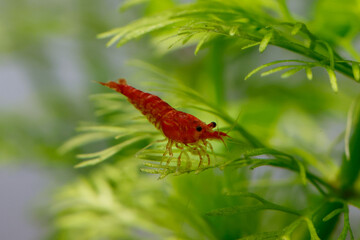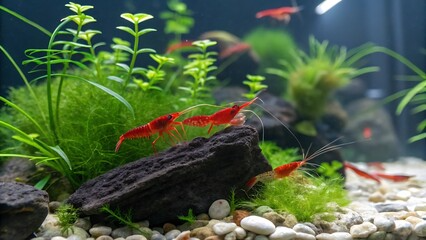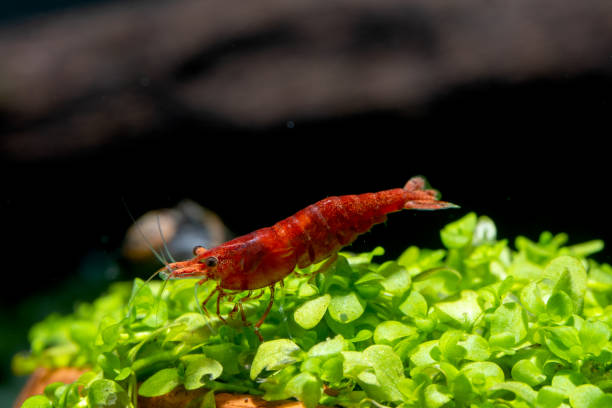Table of Contents
Scientific Classification
| Kingdom | Animalia |
| Phylum | Arthropoda |
| Subphylum | Crustacea |
| Class | Malacostraca |
| Order | Decapoda |
| Family | Atyidae |
| Genus | Neocaridina |
| Species | Neocaridina davidi |
1. Description
The Cherry Shrimp, scientifically known as Neocaridina davidi, is a charming little freshwater shrimp that has captured the hearts of many aquarium enthusiasts. Its striking red hue is a big part of its appeal. Originating from Taiwan, this species has gained popularity not just for its stunning appearance but also for its ease of care. Typically, adult Cherry Shrimp grow to about 2.5 to 4 centimeters in length. Their translucent bodies showcase a vivid red color, particularly in varieties like Fire Red or Sakura. You’ll often find that males are smaller and less vibrant than females, who tend to flaunt a “saddle”—a lighter area on their back that indicates they’re carrying developing eggs.

2. Distribution
Neocaridina davidi, originally from Taiwan, has made its way around the globe thanks to the aquarium trade. This little shrimp has a knack for thriving in various environments, including the United States, Japan, Poland, and Germany, all thanks to its impressive adaptability. You can often find it in thermally polluted waterways, where it manages to survive throughout the year. However, in some regions, the introduction of this species has raised concerns about its impact on local ecosystems.
3. Habitat
Cherry Shrimp thrive in calm, freshwater environments such as streams, ponds, and rice paddies. They prefer spots rich in plants and biofilm, which provide both food and shelter. In aquariums, they flourish in well-planted tanks that offer plenty of hiding places and maintain stable water conditions. The ideal water temperature for them ranges from 14°C to 30°C, with a pH level between 6.5 and 8.0.
4. Diet
When it comes to their diet, Cherry Shrimp are quite the little scavengers! In their natural habitat, they munch on a variety of things like algae, biofilm, detritus, and decaying plant matter. If you’re keeping them at home, high-quality shrimp pellets will do the trick. They also love blanched veggies like zucchini or spinach. And don’t forget to treat them to some protein every now and then, like bloodworms! Interestingly, they even eat their own molted exoskeletons to get back some important nutrients.

5. Behavior
These little shrimp are quite the social butterflies! You’ll often catch them foraging around, looking for tasty morsels on various surfaces. They’re most lively during the day and thrive in groups, making them perfect companions for community aquariums. While they’re generally peaceful, they might feel a bit shy if they’re sharing their space with larger or more aggressive tank mates. To keep them happy and stress-free, it’s a good idea to provide plenty of hiding spots, which also encourages their natural behaviors.

6. Lifespan
When kept in the right conditions, Cherry Shrimp can enjoy a lifespan of about 1 to 2 years. Their longevity is influenced by several factors, such as water quality, diet, and the company they keep in the tank. To help them thrive, it’s essential to maintain a clean environment and stable conditions.
7. Reproduction and Lifecycle
Cherry Shrimp hit sexual maturity at around 30 days old. The females carry about 20 to 30 eggs tucked away under their abdomen, which hatch in roughly 2 to 3 weeks. What’s interesting about Cherry Shrimp is that they don’t go through a larval stage like many other aquatic species. Instead, the little ones are basically mini adults right from the start. They begin foraging almost immediately after hatching, which really helps their population grow quickly when conditions are just right.
. Nest
Cherry Shrimp don’t build nests in the usual way. Instead, the females carry their fertilized eggs attached to their swimmerets (or pleopods) beneath their abdomen. They gently fan the eggs to keep them clean and ensure they receive enough oxygen, which is vital for the embryos to develop properly. Once the eggs hatch, the tiny shrimp scatter off to start their independent lives.
. Mating Season
In aquariums, Cherry Shrimp can breed throughout the year as long as the conditions remain stable. However, in the wild, they tend to breed more during the warmer months when food is plentiful. Factors like temperature, light cycles, and food availability are key in triggering their reproductive behaviors.
. Breeding
Breeding Cherry Shrimp is pretty simple. A well-maintained tank with stable water conditions, plenty of food, and some hiding spots makes it easier for them to breed. After mating, the females take on a “berried” look, carrying their eggs under their abdomen. It’s important to avoid sudden changes in water conditions during this time, as stress can lead to egg loss. Keeping juveniles separate from adult fish or providing dense vegetation can really boost their chances of survival.

8. Predators
In their natural habitats, Cherry Shrimp find themselves on the menu for a variety of fish, amphibians, and larger invertebrates. When kept in aquariums, they can be at risk from tank mates like cichlids, bigger tetras, or any aggressive fish. To ensure their safety, it’s best to keep them with small, peaceful fish or in tanks that are exclusively for their species.
9. Adaptations
- Cherry Shrimp have come up with some pretty clever adaptations to thrive in all sorts of environments:
- Color Variation: Thanks to selective breeding, their colors have become more vibrant, helping them blend in beautifully with aquatic plants.
- Molting: They regularly shed their exoskeleton, which not only allows them to grow but also helps them regenerate.
- Reproductive Strategy: By developing directly without a larval stage, they boost the chances of their young surviving.
- Dietary Flexibility: Their omnivorous diet means they can easily adjust to whatever food sources are available.
10. Conservation Status
Currently, Neocaridina davidi is not listed as threatened or endangered. Its regular sale in the aquarium trade has created stable populations in non-native areas. Monitoring might not seem invasive in many places, but it’s important. It helps prevent possible ecological imbalances.
11. Interesting Facts
Color Grades: Cherry Shrimp are categorized based on how vibrant their colors are. They come in a spectrum from low-grade (which are lighter) to high-grade (which are a rich, deep red).
Self-Cleaning: These little guys munch on biofilm and algae, which helps keep their tank nice and tidy.
Molting Behaviour: After they shed their exoskeleton, they tend to find a hiding spot to protect their soft new shell until it hardens up.
Eco-Friendly: They play a role in reducing the need for chemical treatments for algae in aquariums.
The Cherry Shrimp is not only bright and beautiful but also calm and easy to care for. These qualities make them a fantastic addition to any freshwater aquarium. Whether you’re a seasoned aquarist or just dipping your toes into the hobby, these charming little crustaceans enhance your aquatic environment and add a splash of color.




